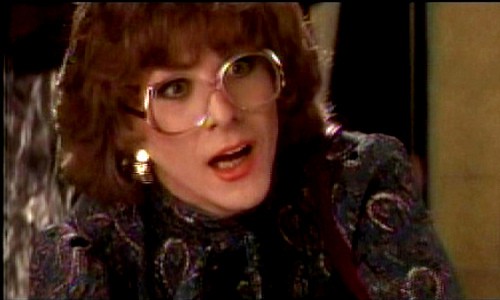Apparently, cross dressing can offer some invaluable life lessons. At least it did for Dustin Hoffman.
One of The Hoff’s more cultic movies was the 1982 comedy-drama, Tootsie. In it, Hoffman played a neurotic and promising actor, Michael Dorsey, who is forced to live as a woman, Dorothy Michaels, in order to get cast in the title role of a film. Most recently published on the blog Mary Sue an AFI interview with Hoffman relates a sensitive, tearful and genuinely emotional actor who found that his experience of making the film left him grieving the missed interactions of interesting women who on first blush appeared physically inadequate:
The truly arresting part of this interview is Hoffman’s vulnerability. The actor describes the movie as being born out of a realization that he himself ignored many women because of their physical appearance. “There are too many interesting women that I have not had the experience to know in this life because I have been brainwashed.” This brainwashing, Hoffman relates, is on fullest display when a woman, “doesn’t fulfill physically the demands that we are brought up to think women have to have in order to ask them out.”
We don’t need a blog post to make us feel guilty for finding pretty things pretty. We are built to find things beautiful. But what I find particularly illuminating is that by admitting that he has overlooked “interesting” women who weren’t beautiful, Hoffman acknowledges that he has merged the concept of beauty and interesting, of the aesthetic with the good.
Oddly, this fusion of interesting and beautiful, or good and beautiful, is not a new problem. In fact, modern art and literature has sought to divorce beauty from goodness, often making readers/viewers agitated (T.S. Elliot, Gertrude Stein, Jackson Pollock, Bertolt Brecht, Antonin Artaud). These artists (not totally successfully) find themselves countering a tradition that hails from Aristotle and has been skillfully maintained by any number of people since: if something is beautiful it is also interesting. If something is beautiful it is also good. And if something is not beautiful, it is likewise not good or interesting. For as John Keats concludes his Ode on a Grecian Urn “Beauty is truth, truth is beauty,–that is all Ye know on earth, and all ye need to know.”
But there’s always been another angle on this point. Shakespeare’s villains had physical deformities, Beethoven’s symphonies were harmonically pleasing, and DaVinci’s depictions of saintly figures were based on studied physical perfections. I wonder what would have happened if these artists had made interesting things that weren’t so beautiful. Would they have been considered as good? Or as interesting? Would their works be lauded? Or their villains be feared? What if DaVinci painted Jesus as a 250-pound man with missing teeth and bowl haircut. Or if Mary was depicted as a woman with a unibrow and a massive nose (think Frida Kahlo meets Kathy Griffin). Would they be any less interesting? Good?
On a trip to Chicago Art Institute’s Contemporary Wing a few months back, a Jesuit friend related that he didn’t like Post-modern art because it “wasn’t good.” I wonder what the Hoff would say about that? Maybe it wasn’t beautiful. But it still evokes emotion. It is still interesting. It is still good.
***
Cover photo “Dustin Hoffman as ‘Tootsie’-1982” is courtesy of flickr user Vintage Gazette


